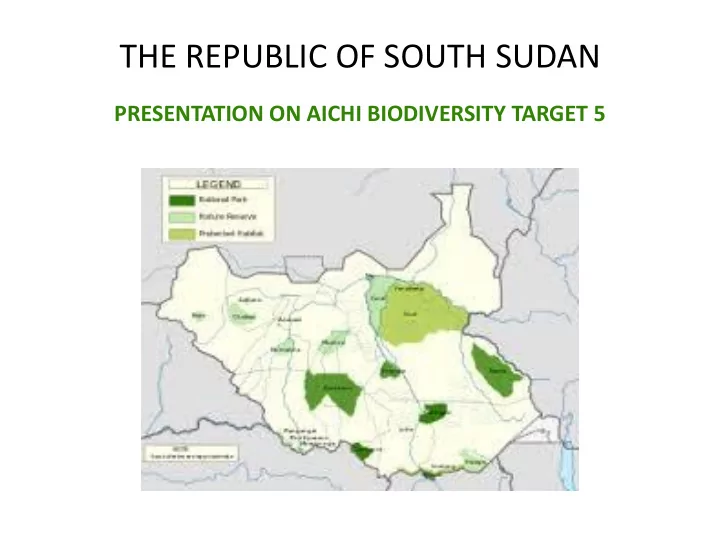

THE REPUBLIC OF SOUTH SUDAN PRESENTATION ON AICHI BIODIVERSITY TARGET 5
THE REPUBLIC OF SOUTH SUDAN • Population of 11.3 million, 83% rural • Abundant natural resources, but very poor country, largely due to the 50 years of conflict Land cover map of 2011 Percent of land area agriculture 4% trees 33% shrubs 39% herbaceous plants 23%
Significant habitats and wildlife populations Example: • Savannah and woodland ecosystems, wetlands (the Sudd) • Biodiversity hot spots: Imatong mountains. • WCS aerial Survey (2007 – 2010) found • 1.2 million white-eared kob and mongalla gazelle • 4000 Elephants and viable populations of other large bodied species.
Drivers of loss of natural habitat and wildlife • 1973 – 2006: annual forest loss 2% per year • Underlying drivers of deforestation: demographic, economic, technological, policy, institutional and cultural factors • Biodiversity assets are threatened by escalating commercial poaching linked to population of fire arms, refugees returning, grazing, water scarcity, extractive industries for oil and minerals
NATURAL HABITATS; INCLUDING FORESTS IN SOUTH SUDAN: - Low land forest. - Maintenance forest. - Savannah wood land. - Grass land savanna. - Flood plain. - Sudd swamps and other wetlands. - Semi-arid region WCS 2012
TABLE: SOUTH SUDAN NATIONAL HABITATS: HABITATS IMPORTANCE THREATS NEW STEPS • • Lowland Manual: chimpanzees, Communities Assessment • • forest elephants, forest hug, Insecurity Management • • Bongo, Buffalo and Illegal Conservation practices forest monkeys. harvesting • Poaching • • Mountain Plants: Albizzia, Farming Law enforcement • • forest podocarpus Hunting Policies • • (9,000 km²) Animals: Bush pig, bush Fire Institutional framework • bug, colobus monkeys, Illegal logging Rich bird life. Protected area. • • Savannah Sited in the iron stone Shifting Community based wood land plateau. cultivation. management and • Elephants, hippos, Rehabilitation collaboration. • giraffe, water birds, sources. Financial strategies • lions. Community participation in law enforcement.
TABLE: SOUTH SUDAN NATIONAL HABITATS: HABITATS IMPORTANCE THREATS NEW STEPS • • Savannah - Sited in the iron stone Shifting Community based plateau. cultivation. wood land management and • - A horn of elephants, Rehabilitation collaboration. hippers, Giraffe, Water sources. • Financial strategies burk, Liones. • Community participation in law enforcement. • • Grass land - Acacia, Balamities, Pastoralists. Strengthening institutions • • combretum and Poachers savannah Proper concession • perennial grasses. Cattle rearing arrangement • - Cheetah, widl dog, lions Concession • Critical awareness to and leopard… policy and decision – makers. • • 5. Flood plain - Animals: Tiang, Nile Insufficient data Information design on the • (112,700 lechwe, Mongalla Poor various species(fauna). Km²) Gazelle coordination. • Improved coordination
TABLE: SOUTH SUDAN NATIONAL HABITATS: HABITATS IMPORTANCE THREATS NEW STEPS • • 6. Sudd - Papyrus common Pollution Need for environmental • swamps and - Fish, phytor, crocodile. Impassive impact assessment • other wet species Assessment of fish species and • land: Pastoralists and others in the Sudd. • fishing Sectoral policies integrated communities. into NBSAP. • • 7. Semi-Arid - Cryx, ostriches and Poaching Conservation and action plan. • Gazzelle Policy measures on protection and insecurity.
Progress in the implementation of Aichi Target 5: 1. South Sudan NBSAP in draft form and not yet approved. - Biodiversity target not yet confirmed, however commendable progress in some areas - could significantly contribute to achieving some of the Aichi targets. 2. South Sudan has undertaken a number of activities to address this target 5 (Table II). 3. Deforestation and degradation of forests are significant contributes to loss of biodiversity.
Table II: STRATEGIC GOALS (B) Reduce the direct pressures on biodiversity and promote sustainable use. TARGETS NATIONAL ACTIVITIES TO ACHIEVE KEY CONSTRAINS TARGET TARGETS By 2020, the rate By 2021, studies Draft policies of Environmental, of loss of all on the rate of forestry, water and others in Absence of a legal natural habitats, habitat loss will be place. framework including forests, furnished towards is a least valued promoting Programming awareness Poor coordination and where implementation of campaigns to local among relevant feasible brought land use policy communities and stakeholders institutions such as close to zero, and and enforcement undertaken to help in forest and wet lands. degradation and of relevant controlling and protection of fragmentation is legislation on natural habitats. Low capacity for natural significantly conservation of resource management. reduced. natural habitats. Capacity building for the forest sector has been supported. Financial limitations. Addressing innovative financial Insecurity (Civil war). mechanism…. PES, NAMA and REDD+
Proposed target 5 • By 2021, studies on the rate of habitat loss will be furnished towards promoting implementation of land use policy and enforcement of relevant legislation on conservation of natural habitats.
Activities to achieve the target Draft policies of Environment, Forestry, Water and others Awareness campaigns to local communities and stakeholders to help in controlling and protection of natural habitats. Capacity building for the forest sector Innovative financial mechanisms - PES, NAMA and REDD+
Strategic objectives and proposed activities under Aichi Target 5 STRATEGIC GOALS AND GENERAL PROPOSED PROPOSED TARGETS OBJECTIVES AND OPPORTUNITIES SPECIFIC THREATS Loss of Assessment level Identify alien species 5. Invasive alien species and indigenous of threat/benefits regulate and prevent pathways are identified and prioritized, priority species species due to introduction and are controlled or CC Regulate manage already existing eradicated, and measures importation of alien species, by 2024 are in place to manage Emerging new harmful species we do assessment and pathways to prevent their species awareness on the introduction and Research impact of invasive on establishment. habitat loss.
CONCLUSION Reduction of loss of natural habitats has important impact on land use, biodiversity and ecosystem services. This can be strengthened through legislation for land-use planning, zoning of forest and policy frameworks. However, the proposed Aichi target 5 in South Sudan is under discussion and final draft November and December 2017 will allow for its endorsement and approval later on. Tinate Thank you
Recommend
More recommend